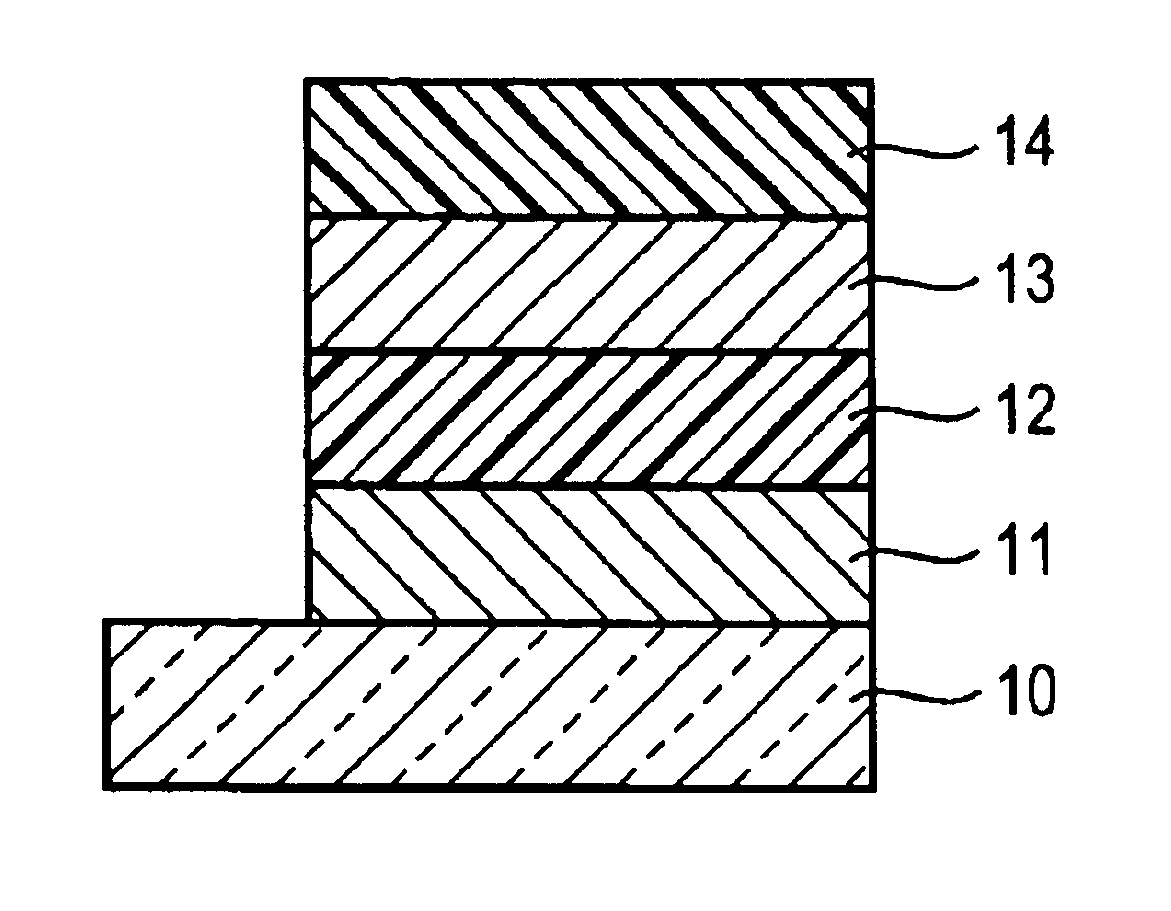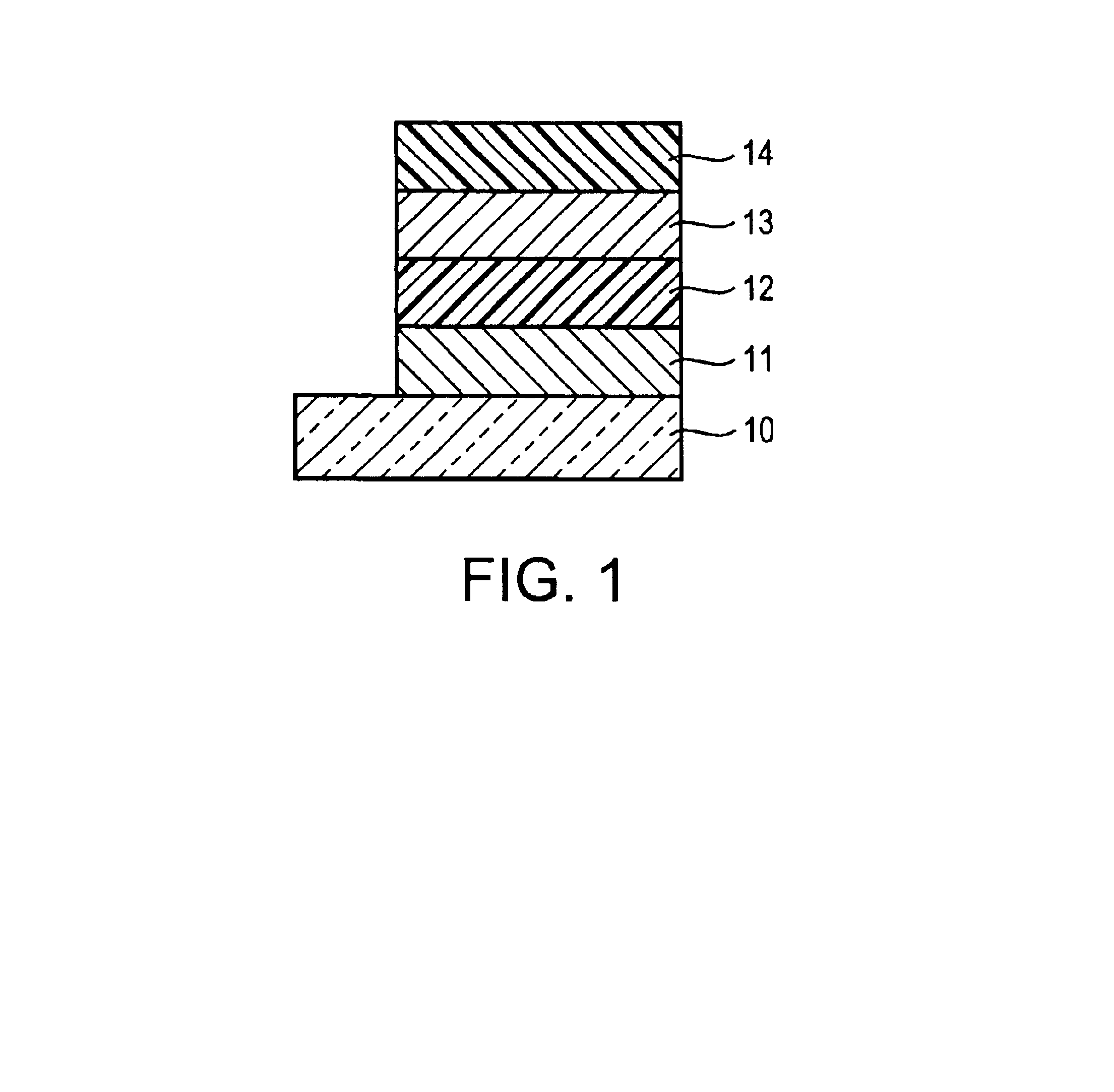Light-emitting element and method of producing the same
a technology of light-emitting elements and light-emitting tubes, which is applied in the direction of thermoelectric devices, semiconductor/solid-state device details, and luminescent compositions, etc., can solve the problems of low light-emitting efficiency, low light-emitting brightness and light-emitting efficiency thereof, and high driving voltage of such elements
- Summary
- Abstract
- Description
- Claims
- Application Information
AI Technical Summary
Benefits of technology
Problems solved by technology
Method used
Image
Examples
example 1
A glass substrate, 0.6 mm in thickness, was cut into 2.5 cm squares, and one of the cut glass substrates was introduced into a vacuum chamber. An ITO target, containing 10% by mass of SnO2, was used to form a transparent electrode, made of an ITO thin film (thickness, 0.2 μm), by DC magnetron sputtering (substrate temperature, 100° C.; oxygen pressure, 1×10−3 Pa). The surface resistance of the ITO thin film was 10 Ω / □. The resultant ITO thin film was etched to produce stripes 5 mm in width.
The substrate, on which the transparent electrode was formed, was put into a washing container and washed with IPA (isopropyl alcohol). Thereafter, the substrate was subjected to UV-ozone treatment for 30 minutes. Next, the surface of the transparent electrode was spin-coated with a dispersed product, wherein polyethylene dioxythiophene / polystyrenesulfonic acid was dispersed in water (Baytron P (trade name), manufactured by BAYER AG; solid content, 1.3%), and subsequently the substrate was vacuum-...
example 2
A light-emitting element was prepared in the same manner as Example 1, except that the metal oxide nanoparticles used in the light-emitting layer was changed to Ga2O3 nanoparticles. The light-emission starting voltage of the resultant light-emitting element was 21 V, and was lower than that of the light-emitting element of Comparative Example 1. The luminous color of the light-emitting element of Example 2 was blue, in the same way as that of the light-emitting element of Comparative Example 1. However, when the brightness was 20 cd / m2, the current of the light-emitting element of Example 2 was 9.9 mA, and that of the light-emitting element of Comparative Example 1 was 36.9 mA. It was learned from these results that the light-emitting element of the present invention, in which its light-emitting layer comprised metal oxide nanoparticles, was superior in light-emitting efficiency.
example 3
A solution was prepared by dissolving 1% by mass of poly(2-methoxy-5-(2′-ethyl)hexoxyphenylenevinylene) (MEH-PPV), which was both a conductive polymer and a light-emitting material, in dichloroethane. This was used as a coating solution for a polymer light-emitting layer. A light-emitting element was prepared in the same manner as Example 1, except that a polymer light-emitting layer, 100 nm in thickness, was formed instead of the hole transport layer, and further, a light-emitting layer was formed by applying a colloidal solution in which 4% by mass of ZnO nanoparticles were dispersed in ethanol.
PUM
| Property | Measurement | Unit |
|---|---|---|
| thickness | aaaaa | aaaaa |
| thickness | aaaaa | aaaaa |
| particle diameter | aaaaa | aaaaa |
Abstract
Description
Claims
Application Information
 Login to View More
Login to View More - R&D
- Intellectual Property
- Life Sciences
- Materials
- Tech Scout
- Unparalleled Data Quality
- Higher Quality Content
- 60% Fewer Hallucinations
Browse by: Latest US Patents, China's latest patents, Technical Efficacy Thesaurus, Application Domain, Technology Topic, Popular Technical Reports.
© 2025 PatSnap. All rights reserved.Legal|Privacy policy|Modern Slavery Act Transparency Statement|Sitemap|About US| Contact US: help@patsnap.com


